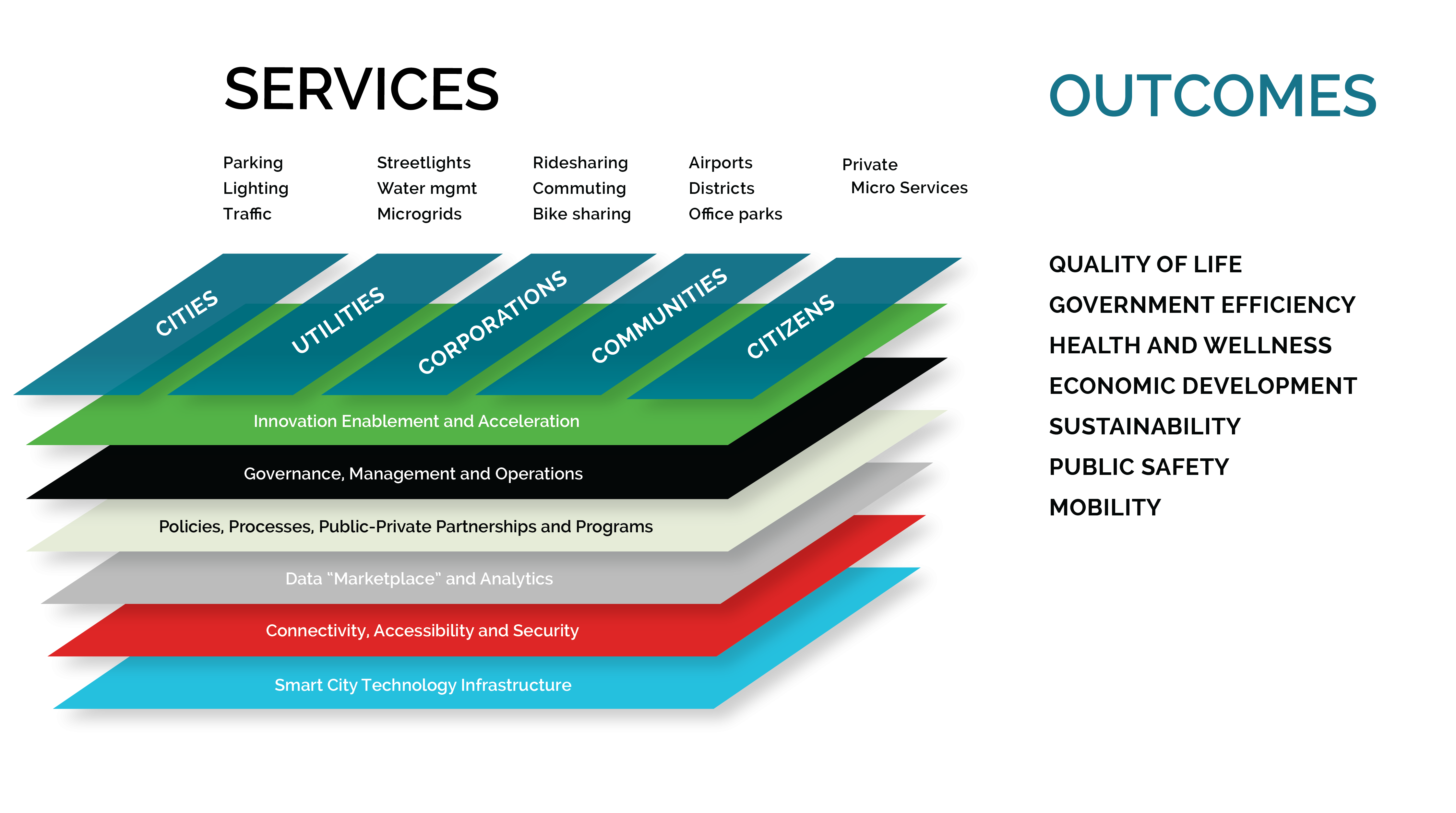What is a smart city? The answer depends on who you ask. Solutions providers will tell you it’s smart parking, smart lighting or anything to do with technology. City officials may tell you it’s about conducting city business online, such as searching records or applying for permits. City residents may tell you it’s the ease of getting around, or about crime reduction. Everyone is right. A smart city, built properly, will have different value for different stakeholders. They may not think of their city as a “smart”city. They know it only as a place they want to live in, work in, and be a part of. To build this type of city, you have to first build the smart city ecosystem.
A smart city is built on technology, but focused on outcomes
A scan of the various smart city definitions found that technology is a common element. For example, TechTarget defines a smart city as “a municipality that uses information and communication technologies to increase operational efficiency, share information with the public and improve both the quality of government services and citizen welfare”. The Institute of Electrical and Electronics Engineers (IEEE) envisions a smart city as one that brings together technology, government and society to enable the following characteristics: a smart economy, smart mobility, a smart environment, smart people, smart living, smart governance.
But what does a smart city really do? Our scan of smart city projects worldwide showed that initiatives fell into one or more smart city “outcomes” (Figure One).
 Figure One. Smart city projects are aligned to one of seven outcomes.
Figure One. Smart city projects are aligned to one of seven outcomes.
As a starting point, we define a smart city is one that uses technology extensively to achieve key outcomes for its various stakeholders, including residents, businesses, municipal organizations and visitors.
The smart city ecosystem framework
Figure Two shows our framework for a smart city ecosystem. A vibrant and sustainable city is an ecosystem comprised of people, organizations and businesses, policies, laws and processes integrated together to create the desired outcomes shown in Figure One. This city is adaptive, responsive and always relevant to all those who live, work in and visit the city. A smart city integrates technology to accelerate, facilitate, and transform this ecosystem.
 Figure Two. The smart city ecosystem framework.
Figure Two. The smart city ecosystem framework.
Four types of value creators
There are four types of value creators in the smart city ecosystem. They create and consume value around one of the outcomes listed in Figure One.
When people think of a smart city, they automatically think of services provided by municipal and quasi-government agencies, such as smart parking, smart water management, smart lighting, and so on. In fact, there are three other value providers and users that co-exist in the smart city – businesses and organizations, communities, and residents.
Businesses and organizations may create services that use and create information to create outcomes for its stakeholders. Some examples of “smart” businesses include Uber and Lyft for personal mobility, NextDoor for information sharing, and Waze/Google for traffic and commute planning.
Communities are miniature smart cities, but with very localized needs. Some examples of potential smart communities include university campuses, office parks, airports, cargo ports, multi-dwelling unit (MDU) or apartment complexes, housing developments/neighborhoods, business districts and even individual “smart” buildings. They have needs for smart services that may be tailored specifically for their stakeholders.
Residents or individual citizens are also smart services providers in the smart city. A resident living near a dangerous street intersection can point a camera at the intersection and stream that information live to traffic planners and police. Residents place air quality measurement sensors on their properties to monitor pollution and pollen levels during certain times of the year, and make that information available to other community members. Residents can choose to make these smart services temporary or permanent, and free or fee based.
The Smart City is built on layers
A smart city is an ecosystem comprised of multiple “capability layers”. While technology is a critical enabler, it is just one of many foundational capabilities that every smart city must have. No one capability is more important than the rest. Each capabilities plays a different role in the smart city. These capabilities must integrate and coordinate with each other to carry out its mission.
Value layer. This is the most visible layer for city residents, businesses, visitors, workers, students, tourists and others. This layer is the catalog of smart city services or “use cases”, centered around the outcomes (Figure One), and offered by value creators and consumed by the city stakeholders.
Innovation layer. To stay relevant, value creators in the smart city must continuously innovate and update its services for its stakeholders. Smart cities proactively facilitate this through a variety of innovation programs, including labs, innovation zones, training, ideation workshops, skills development and partnerships with universities and businesses.
Governance, management and operations layer. The smart city creates disruption and results in digital transformation of existing processes and services. Smart city management models must integrate a new ecosystem of value creators and innovators. They must plan, support and monetize new business models, processes and services. They must upgrade their existing infrastructure and management processes to support “smart” services. Finally, they must measure the performance of the city with a new set of metrics.
Policy, processes, and public-private partnerships, and financing layer. The smart city doesn’t just magically appear one day. An entirely new set of engagement models, rules, financing sources, and partners are required to build, operate and maintain the smart city. Cities must develop a new set of “smart” competencies in order to get and stay in the “smart city game”.
Information and data layer. The lifeblood of the smart city is information. The smart city must facilitate this in several ways, including open data initiatives, data marketplaces, analytics services, and monetization policies. Equally important, they must have programs that encourage data sharing and privacy policies to protect what and how data is gathered.
Connectivity, accessibility and security layer. People, things and systems are interconnected in the smart city. The ability to seamlessly connect all three, manage and verify who and what is connected and shared, while protecting the information and users is crucial. The highest priorities for smart cities are to provide a seamless layer of trusted connections.
Smart city technology infrastructure layer. Most people automatically think of technology when talking about smart cities. The smart city technology infrastructure must scale beyond the traditional municipal users and support a new class of value creators, and city/user stakeholders.
Leveraging the smart city ecosystem framework
The smart city is a complex ecosystem of people, processes, policies, technology and other enablers working together to deliver a set of outcomes. The smart city is not “owned” exclusively by the city. Other value creators are also involved, sometimes working in collaboration and sometimes by themselves. Successful and sustainable smart cities take a programmatic approach to engage its stakeholders across the ecosystem.
Our research has found that many cities are not taking an ecosystem approach to smart city projects. This is due in part to smart city projects being managed by the Information Technology (IT) organization where their charter is on systems development and deployment. In contrast, more experienced smart cities manage their smart city programs through internal cross functional “Transformation” or “Innovation” organizations.
Regardless of where cities are in their smart city journey, they must get ahead of the “curve” with smart city projects. They begin by thinking in terms of building the broader ecosystem in order to create a sustainable and scalable smart city. Key next steps include:
- Understand the smart city ecosystem framework and tailor it to the realities of their specific city. Incorporate this model into the development of their smart city vision, strategy and execution plans.
- Relative to the smart city ecosystem framework, identify current capabilities and gaps across the various layers. Understand what is needed to support the four types of value creators.
- Evaluate existing and new smart city projects and initiatives against the ecosystem framework. Use this framework to identify what is missing from the project plans and what is needed to make the projects fully successful.
- Prioritize and develop competencies across the various ecosystem layers. A smart city requires new skills and competencies. Augment existing capabilities through strategic partnerships and contracting with service providers, as required.
About:
Benson Chan is an innovation catalyst at Strategy of Things, helping companies transform the Internet of Things into the Innovation of Things through its innovation laboratory, research analyst, consulting and acceleration (execution) services. He has over 25 years of scaling innovative businesses and bringing innovations to market for Fortune 500 and start-up companies. Benson shares his deep experiences in strategy, business development, marketing, product management, engineering and operations management to help IoTCentral readers address strategic and practical IoT issues.
This post was co-authored with Renil Paramel, an IoT Innovation Catalyst, Strategist and Senior Partner at Strategy of Things.











